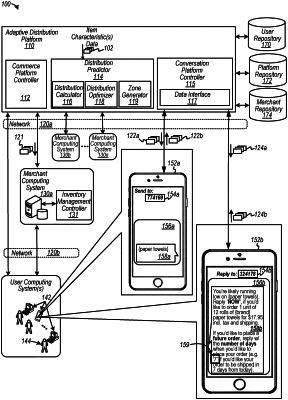| CPC G06Q 30/0631 (2013.01) [G06Q 30/0267 (2013.01); G06Q 30/0271 (2013.01); G06Q 30/0633 (2013.01); H04W 4/14 (2013.01)] | 19 Claims |

|
1. A method, comprising:
receiving at a transaction controller a plurality of requests including data representing multiple items associated with multiple zones of time to be replenished by an adaptive distribution platform;
analyzing an electronic request message at the transaction controller including a machine learning application to extract automatically data representing an item characteristic from a user request to replenish a first item;
correlating the item characteristic associated with the first item of the multiple items to form an aggregated item characteristic;
aggregating usage rates to form an aggregated usage rate to predict a predicted distribution date of the first item;
predicting predicted distribution data and associated with other characteristic data of the first item, the predicted distribution data includes a first range of time to determine the predicted distribution date of the first item, the first range of time being adjusted as a function of the aggregate usage rate;
implementing the machine learning application configured to identify the user request from various types of electronic request messages and configured to implement an action based on the predicted distribution data, which is configured to automatically modify execution of the machine learning application to extract item characteristics to predict a subsequent item characteristic the machine learning application being configured to distinguish a number of subsets of data points representing statistically similar attributes, each subset of data points being a cluster of data grouped to include the first item based on similar attributes,
wherein to optimize item distribution for each user by the adaptive distribution platform the machine learning application automatically adjusts item characteristic values based on results of an analysis of user purchasing patterns;
linking the item characteristic of the first item based on the statistically similar attributes to profile data including user-identification data to implement the action, the profile data being selected based on the predicted subsequent item characteristic that is based on the modified execution of the machine learning application to distinguish and identify the first item based on the statistically similar attributes;
generating a control signal to a merchant computing system, the control signal including control data associated with replenishing the first item and the profile data including user-identification data; and
predicting a sample as a second item based on the aggregated item characteristic associated with the first item and the other characteristic data of the first item to generate an adaptive schedule for transmitting electronic messages to automatically facilitate feedback regarding the second item at intervals of time during which consumption of the sample is predicted to provide an assessment whether to generate an order or subscription for delivery of the another item based on the sample,
wherein the second item is predicted as a complementary item to the first item, both of which are provided substantially simultaneously.
|